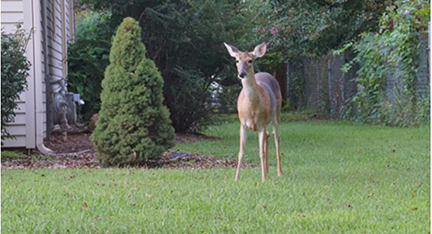by Tim Crosby
CARBONDALE, Ill. – Deer and other wild animals moved more freely during the COVID-19 lockdowns, according to a new study, which included work from a researcher at Southern Illinois University Carbondale.

The study, published Friday (June 9) in the journal Science, reflected another impact of the lockdowns, which kept people indoors more while giving wildlife the green light to move more freely by “disentangling” humans’ impact on the wildlife movement patterns.
As one of more than 170 co-authors of the study, Guillaume Bastille-Rousseau, assistant professor with SIU’s Cooperative Wildlife Research Laboratory, played a small but important role in the work. He was able to use long-term data from deer he and others at the CWRL have been collaring since 2018 at both SIU’s Touch of Nature Outdoor Education Center and Lake Shelbyville in central Illinois.
“Overall, our findings were in line with the overall findings of the study,” Bastille-Rousseau said. “The stringency of the lockdown in the USA overall, and in Illinois, was not as high as other parts of the world, so there was still a bit of human activity at our sites. That meant the change of movement in deer during the lockdown and afterwards was not as marked as observed with other species.”
Looking back on lockdowns
The pandemic lockdowns resulted in a drastic reduction in human mobility, the study’s authors stated. While not only often confined to their homes, the measures also saw officials shut down recreation areas – both wild and otherwise – which also greatly reduced automobile traffic and its noise, too.
This “anthropause,” as the authors call it, provided a unique opportunity to quantify the effects of specifically human mobility on wildlife by decoupling it from other factors, such as the effects of landscape and environmental changes.
Piggybacking on other studies
Bastille-Rousseau was already engaged in deer movement studies for several years, leading to a good number of collared deer under his surveillance at the two Illinois locations.
Using clover traps – a giant box-like trap – drop nets and dart guns, Bastille-Rousseau and his students captured and then fit the deer with GPS collars that are programmed to take a reading on their locations every 30 minutes or every hour.
“These locations are then sent back to us via satellite,” he said. “We then analyze the information on deer movement with several goals in mind, ranging from understanding disease transmission to how the deer respond to predators, such as coyotes or bobcats.
Having the cache of trackable wildlife already available for analysis made Bastille-Rousseau a ready partner for the study released today.
“There was an opportunity that emerged from these long-term tracking data to assess how deer could have been impacted by change in humans’ behavior, for example, during the early days of the pandemic with the stay-at-home orders,” he said.
Lockdowns and wildlife
During the early days of the pandemic lockdowns, stories emerged in mainstream media of animals reasserting their presence in cities, Bastille-Rousseau recalled. The researchers’ work provides some science to back up those observations.
For example, the data showed that in areas with very strict lockdowns, animal movement drastically increased. The animals also avoided roads less than they normally would, possibly owing to the marked decrease in traffic during the stricter lockdowns.
In other areas less-strictly locked down, residents could still take advantage of natural areas.
“Doing that provided a bit of relief from everything for those people,” Bastille-Rousseau. “But in those areas, the change in animal movements was not as apparent.”
